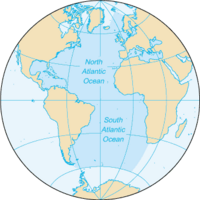
Photo from wikipedia
Abstract The Chukchi Sea is a primary site for shelf-ocean exchange in the Arctic region and modifies Pacific-sourced water masses as they transit via the Bering Strait into the Arctic… Click to show full abstract
Abstract The Chukchi Sea is a primary site for shelf-ocean exchange in the Arctic region and modifies Pacific-sourced water masses as they transit via the Bering Strait into the Arctic Ocean. The aim of this study was to use radium and trace metal distributions to improve our understanding of biogeochemical cycles in the Bering and Chukchi Seas, and evaluate their potential response to future changes in the Arctic. We investigated the distributions of dissolved and total dissolvable trace metals (Cd, Fe, Ni, Cu, Zn, Mn, Co, and Pb) in the Bering and Chukchi Seas during spring. In addition, the long-lived radium isotopes (226Ra and 228Ra) were measured as tracers of benthic trace metal inputs. Trace metal concentrations, especially Fe and Mn, were highly elevated in Chukchi shelf waters compared with the open Arctic Ocean and Bering Strait. Trace metal, nutrient, and Ra patterns suggested that Fe, Mn, and Co concentrations were predominantly controlled by reductive benthic inputs, whereas the other trace metals were influenced by biological uptake and release processes. We propose that Fe, Mn, and Co in the Chukchi Sea are supplied from shelf sediments during winter overturning, and we combine the 228Ra fluxes with the distributions of Fe, Mn, and Co to provide a first estimate of their benthic fluxes in the region. The average benthic flux of 228Ra was 1.49 × 108 atoms m−2 d−1, which is among the highest rates reported globally. Estimated dissolved Fe (D-Fe) flux from the sediments was 2.5 μmol m−2 d−1, whereas D-Mn and D-Co fluxes were 8.0 μmol m−2 d−1 and 0.2 μmol m−2 d−1, respectively. The off-shelf transport of D-Fe to the Arctic Ocean is estimated to be about 10–25% of the benthic Fe flux, with the remainder retained on the shelf due to scavenging and/or phytoplankton uptake. Our results highlight the importance of the Chukchi Sea as a major source of the micro-nutrients to the Arctic Ocean, thereby supporting primary production. Long-term changes in factors that affect cross-shelf mixing, such as the observed reduction in ice cover, may therefore enhance shelf nutrient inputs and primary productivity in the Arctic.
Journal Title: Marine Chemistry
Year Published: 2019
Link to full text (if available)
Share on Social Media: Sign Up to like & get
recommendations!